Whether it’s Wadget or Apep from Egypt, Asclepius from Greece, Midgard or the Australian Rainbow Snake, Snake Gods are prevelant in ancient mythologies from all around the world.
Feared by many people today, many ancients saw serpents as deities, both good and evil. The stories and representations of these gods remain as fascinating as ever.
Table of Contents
Wadjet – Snake God of Egypt,
Wadjet
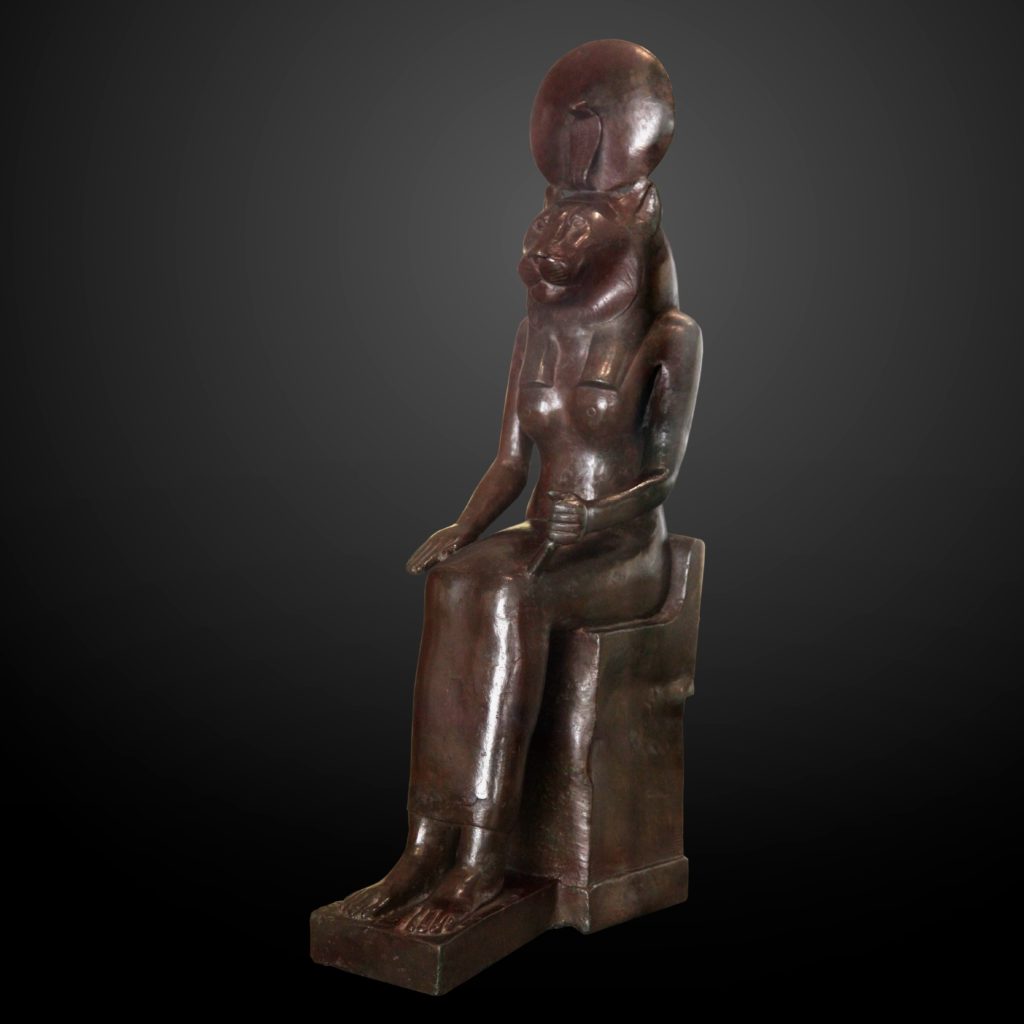
This Egyptian cobra goddess on our list is known to be guardian of childbirth and children. Later depictions associate Wadjet with the protection of the pharaohs.
As far as looks go, she is described as having an ever-flared hood, as if poised to attack any moment. This interpretation of Wadjet can likely be tied in with her relation to Egypt’s pharaohs, and relate either to her unwavering ward, or the pharaoh’s role to protect and lead the realm.
Other depictions of the goddess has her wearing the Red Crown (also known as the deshret) of Lower Egypt, the land surrounding the Nile delta, thus establishing her as being one of the patron goddesses of the region. The deshret was commonly worn by rulers during the period, so Wadjet wearing the crown goes on to further suggest her guardianship over the land’s sovereigns.
Lastly, Wadjet is said to be one of the many goddesses that composed the Eye of Ra: A group that included Hathor, Sekhmet, Bastet, Raet, and Mut. Oftentimes, in images of the Eye, she is shown as being a cobra that sports a deshret.
Renenutet – Egyptian Snake Goddess
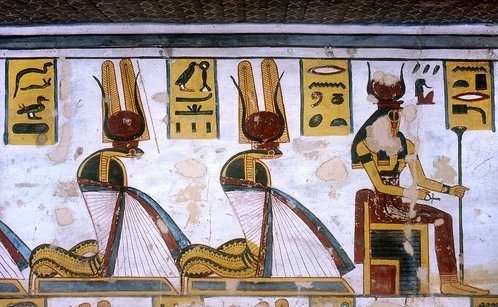
Unlike the straight-forward Wadjet, when it comes to Renenutet, appearances can prove to be shaky. This Egyptian goddess has quite a few alternating looks.
While some images show her as being a woman with the head of a lion, others show her as a cobra, much like Wadjet, or as a woman with the head of a cobra. She would be shown wearing a double plumed headdress, or as having a solar disk around her.
Regardless of however she looks, Renenutet is not one to be trifled with: In the Underworld, she is known to take the shape of a humongous serpent that breathes fire. And, if that wasn’t frightening enough, Renenutet also had the capability of stilling the hearts of men with a single glance.
Also, she is sometimes considered to be the mother of Nehebkau, the giant serpent that guards the gates of the Underworld. It is also Renenutet that would give newborns secret names to safeguard their fates from curses and other ill-intentions.
Foregoing the whole deadly Underworld serpent thing, Renenutet sounds like one hell of a mother-figure: “She Who Rears” is quite the fitting epithet after all.
Nehebkau – Primeval Egyptian Snake God
Nehebkau is one of the original primeval gods in Egypt and is speculated to be the son of the goddess Renenutet. Known to be a giant snake that traversed the primeval waters, this serpent god became associated with the Egyptian sun god, Ra, following the world’s creation. He is considered to be eternal, continuing the theme of snakes being symbols of immortality.
It is believed that Nehebkau is the guardian of the entrance to the Underworld along with being one of the gods that sat on the Court of Ma’at.
The Court of Ma’at was a compilation of 42 minor gods that aided Osiris in passing judgment with the Weighing of the Heart. There is a chapter in the Book of the Dead that gives a detailed list of all these gods and the region they are associated with.
Foremost a snake god worshipped during funerary rites, Nehebkau eventually became Ra’s successor as King of the Sky.
Meretseger – Egyptian Snake Goddess of Mercy and Punishment
Viewed frequently as a goddess of mercy and punishment, Meretseger watched over the dead and punished grave robbers. Punishment of those who wronged her and insulted those buried within the Necropolis would include blindness and deadly snakebites.
You would guess that for a goddess whose name means “She Who Loves Silence,” troublemakers would figure out to mind their own business!
Meretseger had guardianship over the sprawling Theban Necropolis. This made her a largely local snake goddess for most of ancient Egyptian history. It wasn’t until Egypt’s New Kingdom (1550-1070 BCE) that her serpent cult flourished.
Apep – Egypt’s Snake God of Chaos and Death
Best known as being the “Lord of Chaos,” or the “god of death,” Apep is no ordinary snake. As one of the first Egyptian deities to have existed, he is oftentimes described to be a giant, malevolent serpent deity. On the other hand, a few renditions do portray him as a crocodile.
Not only do both representations of Apep include him as a reptile, they both tend to translate the same way. Much like snakes, crocodiles were feared and revered. Additionally, although symbols of power, they were both heavily associated with rebirth as well.
Ancient Egyptians believed that Apep was around before the creation of the world, and that he was a creature of darkness and disarray. The sun god Ra would fight Apep nightly to ensure that cosmic balance would remain, to which the Lord of Chaos would fall only to rise again.
READ MORE: Egyptian Gods and Goddesses
Asclepius – Greek Snake God of Medicine
Initially described as an average Joe in Homer’s Iliad, Asclepius went on to be deified across ancient Greece for his medical prowess. Although a mere physician, popular belief would render him a son of Apollo and a mortal princess and, by divine right, a god.
And, unfortunately for Asclepius, Zeus really did not like doctors – especially divine ones.
Afraid that he would grant man immortality, Zeus killed Asclepius. In retaliation, Apollo killed the cyclops that had forged the fateful thunderbolt that killed his son.
Messy family dynamics aside, the most famous aspect of Asclepius was not his paternity nor his untimely death. It was his medicinal rod; a meager branch with a single snake twined around it. Not to be mistaken with Hermes’ Staff Caduceus — a staff with two intertwined snakes and a set of wings — the Rod of Asclepius was far simpler fare in comparison.
In modern medicine, the Rod of Asclepius is used interchangeably with the Caduceus.
A repeating theme present in Greek mythology is the view of serpents being divine messengers: Symbols of life and death. Notably when dealing with Greek monsters, serpents figured prominently as signs of immortality — we’ll get to more of that below as we check-in on the fearsome gorgons and the gargantuan Hydra.
The Gorgons – Three Greek Snake Goddesses
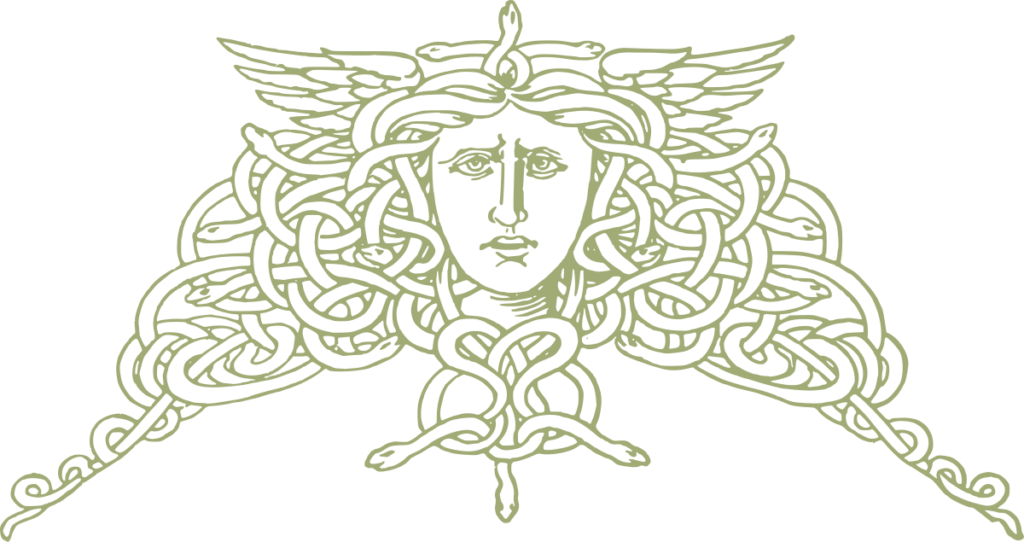
Continuing on, it would be unfair to neglect the inimitable powerhouses that are the Gorgons. These three vicious female monsters are known as Stheno, Euryale, and Medusa. Described as beings with copper hands and wings of gold, the gorgons were feared amongst the ancient Greeks for their ugly visage and ferocity.
While the tale of Medusa is infamous and disputed to this day, as far as everyone is aware, she is the only one of the gorgons that is not immortal, having been born a human being.
Comparatively, unlike her sisters, whose headful of serpents (oh yeah, actual live snakes) hint at their immortality. It can be speculated that Medusa’s transformation from a beautiful mortal to a hideous serpentine beast could instead show the rebirth quality of snakes. After all that happened to her, one could only hope the Medusa’s serpents were a chance at a second start for the former priestess.
The Hydra – Greek Snake God Monster

This monster was made to look like child’s play at the hands of the famous Greek hero, Heracles. Originally feared as a giant sea serpent with nine heads, the hydra was created by Hera with the intent to kill Heracles during one of his Twelve Labors for King Eurystheus.
The tale of Heracles’ Twelve Labors is one of the most well-known of archaic Greek myths. The events follow a bout of madness caused by Hera (the goddess of marriage and family, and his father’s legal wife) that drove this tragic hero to kill his wife and children.
So, the catch with the hydra was that it had the worst breath ever (we’re talking literal lethal poison) and if nine heads was not enough then after Heracles cut off one, two more grew in its place; this quirky feature of the massive sea serpent ties right back in with — you guessed it — immortality!
Yeah, Hera was determined to kill this man.
Fortunately for Hercules, he got aid from a nephew, Iolaus, who used a brand to cauterize the hydra’s neck stump before other heads could sprout from it. Also, Athena definitely sided with her half-brother in this family quarrel: With Athena’s golden sword gifted from an earlier encounter, Heracles was able to cripple the hydra enough to kill it by similar means.
READ MORE: Greek Gods and Goddesses
The Rainbow Snake – Australia’s Creation Serpent
The Rainbow Serpent is the primary creator god in Indigenous Australian mythology. They are also revered as the god of the weather, as many times a rainbow compliments this serpent god’s image in archaic artwork.
It should be noted that “Rainbow Serpent” is a blanket term adopted by anthropologists when they were faced with loosely similar tales across all of Australia regarding a giant snake that was the creator of life itself. Naturally, these creation stories varied from People and respective Nations who have their own name for the life-giving snake.
However, the indisputable root of life that the Rainbow Snake provided was water, regardless of story. Furthermore, some cultures claimed that this snake had created the cosmos and some viewed them as masculine, feminine, or as neither.
READ MORE: Who Invented Water? History of the Water Molecule
As the story goes, the Rainbow Serpent slept beneath the earth for millennia, until it rose out of the ground one day. When the giant snake traveled, the earth’s terrain began to form. Where they roamed, other animals awoke. It is believed that the serpent occupied bodies of water, therefore establishing it as representing the significance of water as well as the changing seasons.
Norse Serpent God: The Midgard Serpent Jormungandr

Where to begin with Jormungandr…
Well, being the world serpent isn’t the easiest job to have, coiled around the earth and beneath the sea while biting your own tail.
No, the job of the Midgard Serpent does not sound like fun at all.
Also, he cannot be having a great time when his siblings include the demon wolf Fenrir and the Norse goddess of death, Hel.
Even worse? His uncle, Thor, hates him.
Like…Hera’s feelings towards Heracles type of hate. In fact, in their final showdown, the two end up killing each other.
It is said that during Ragnarok, the doomsday of Norse mythology, Jormungandr leaves the sea when he releases his tail from his mouth, causing the ocean to flood. Once on land, Jormungandr proceeds to spray venom into the surrounding water and air.
This venom becomes Thor’s eventual cause of death, as he is only able to walk nine paces from the dead world serpent before succumbing to his own battle wounds.
READ MORE: Norse Gods and Goddesses
Ningishzida and Mushussu – Snake Gods of Mesopotamia
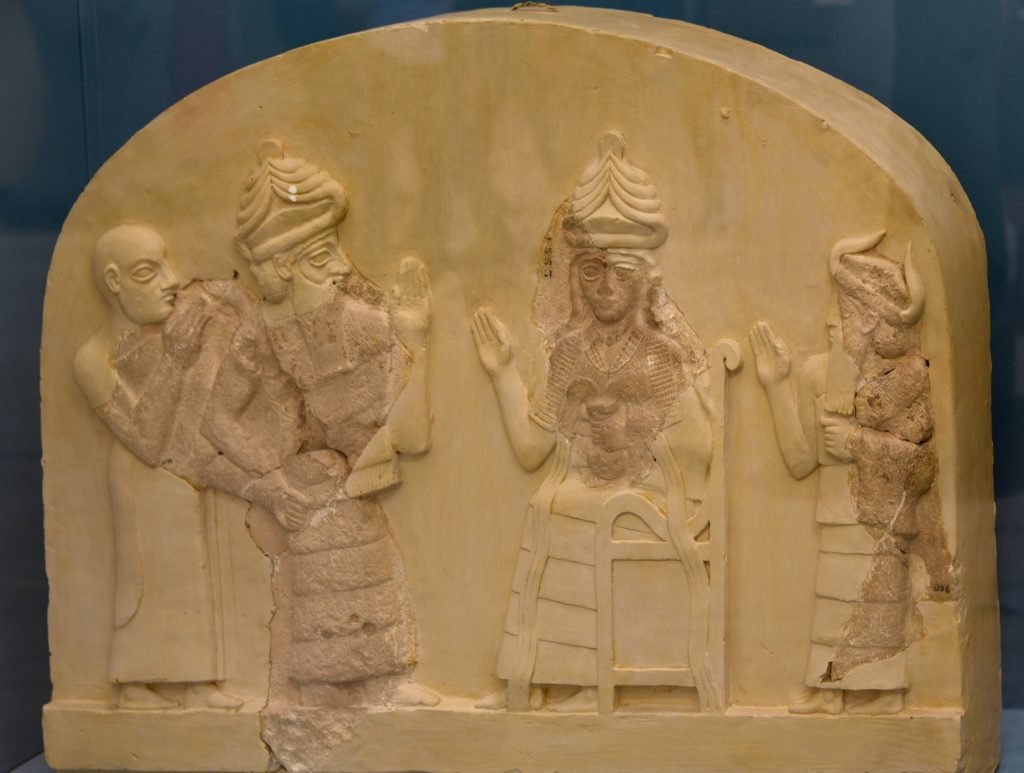
This Sumerian god is a complex individual. Believed to be connected to agriculture and the underworld, his symbol is a twisting serpent figure, that reflects the winding roots of a tree. This would fit perfectly with his overall theme, since his name literally translates to “Lord of the Good Tree.”
Another symbol that is associated with Ningishzida is an image of the great serpent Basmu wound around a branch. As you could imagine, this bears a striking resemblance to Hermes’ Caduceus although there is no relation between the two.
Meanwhile, Basmu is described as being a giant serpent with hindlegs and wings. Their name roughly translates to “Venomous Snake” and they seem to represent rebirth, death, and mortality. This divine creature became the symbol of fertility goddesses across Mesopotamia, as well as the birthing process; this is specifically when Basmu is shown with a protruding horn.
Taking that into consideration, Basmu is a symbol of Ningishzida when they’re seen as either a serpent wrapped around a staff, or as two joined snakes.
Few scholars additionally speculate if the tree in Ningishzida’s name could instead reference a vine, since the god is also closely linked to alcohol (similar to the Greek Dionysus).
Mushussu – Mesopotamian Guardian Snake God
With a name that means “Furious Snake,” you can imagine that this serpent spirit was not one to back down from a challenge.
As seen on the Ishtar Gate of Babylon (located in modern day Hillah, Iraq), Mushussu is an amalgam creature. They are presented as having a slender, dog-like body covered in smooth scales with a long neck, a horn, and a forked tongue.
Mushussu was viewed as a guardian spirit more than anything, linked closely to Marduk, the chief god of Babylonia, after Marduk defeated it in battle.
Eopsin – Korean Snake God
Eopsin is the goddess of wealth and storage in Korean folk mythology. Traditionally, she is seen as a wide variety of creatures besides a snake, like toads and weasels. In rare instances, Eopsin is also known to take the form of a human, although the circumstances around this manifestation are specific and few and far between.
Usually the serpent goddess takes up residence in the roofs of homes. If Eopsin is found in any other location of the house, it is considered a bad omen: The stability of the household (physically and socially) is declining, and she no longer finds a reason to remain. Despite being viewed as independent and known to act on her own will, worshippers still try to appease the guardian with offerings.
Besides being the guardian of the home and worldly possessions, Eopsin is also a mother to seven other Korean goddesses according to the Chilseong Bonpuli. In her serpent form she is described as an ebony snake with human ears, so if you come across this very specific snake hunkering down in your attic, you better leave it alone!
Quetzalcoatl: Aztec Feathered Serpent God

A feathered serpent of Aztec myth, Quetzalcoatl is believed to be the creator of man, and the dividing deity between the land and the sky. The earliest records in existence indicate this snake god was closely tied to the rain and water god, Tlaloc, and that his original domain was vegetation.
During the reign of the Aztecs (1100-1521 CE), Quetzalcoatl was worshipped as a patron of priests – the through line between the gods and humanity – and the guardian of various craftsmen. Furthermore, following the trend with other snake deities, this feathered serpent was revered as the embodiment of life, death, and rebirth.
READ MORE: Aztec Gods and Goddesses
The Five Nagas – Hindu Serpent Deities
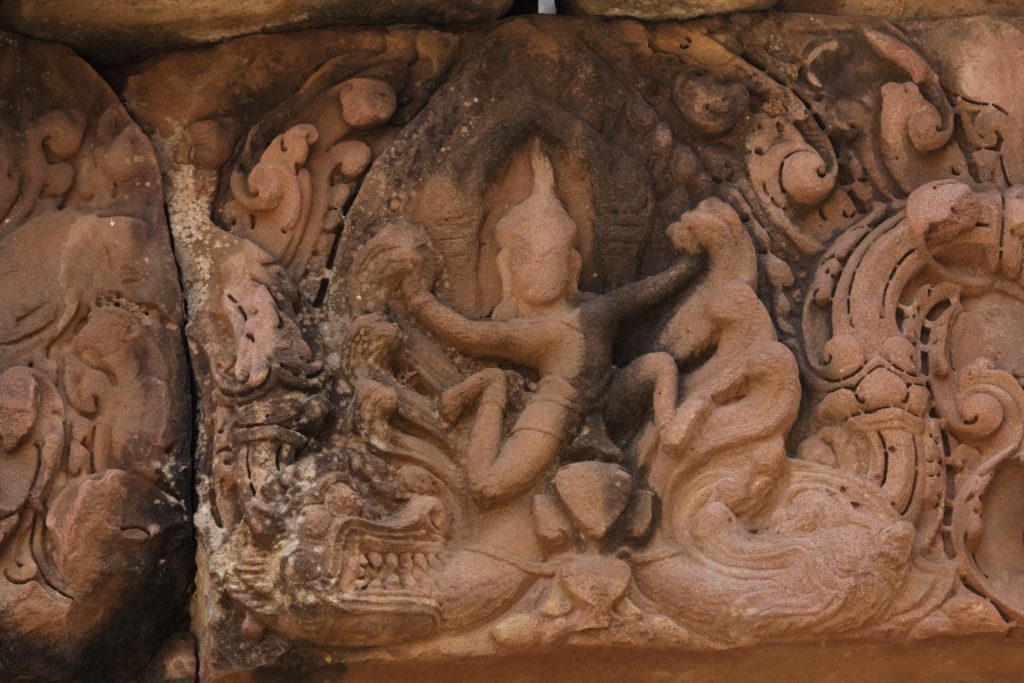
In Hindu mythology, Nagas are divine beings that are half-serpent, and can assume the form of a human or of a snake. They are revered as beneficial deities, though they have proven themselves to be formidable foes throughout mankind in Hinduism.
Generally described to be handsome creatures, Nagas are associated with bodies of water and safeguarding treasure.
Adishesha
The eldest brother of Takshaka, Vasuki, and well over a hundred serpents, Adishesha is known as another Naga king. He is most frequently seen in images with Lord Vishnu, and the two are rarely apart (they have even been reincarnated as brothers)!
It is also said that at the end of time, when all is destroyed, Adishesha would remain as he is. That’s right: Shesha is eternal.
Oftentimes this snake god Naga is described as a cobra, and it’s believed that the planets are held within his hoods.
Astika
The son of the sage Jaratkaru and the serpent goddess Manasa Devi, Astika is one out of five of the most prominent Nagas of Hindu mythology. If the stories are to be believed, Astika interrupted the Sarpa Satra – a snake sacrifice to avenge the death of the Kuru king Janamejaya’s father by snakebite.
Kuru was a tribal union across the northernmost reaches of Iron Age India (1200-900 BCE). Modern states that composed Kuru include Delhi, Haryana, and Punjab.
Not only did Astika turn out to save Takshaka, one of the King of Nagas and a companion of Indra, but he also successfully petitioned the king to end the prosecution of snakes throughout the realm.
The day is now celebrated as Naga Panchami in modern practices of Hinduism, Buddhism, and Jainism.
Vasuki
This other Naga king is best known as a companion of Lord Shiva. In fact, Shiva was so fond of Vasuki that he blessed him and wore the serpent as a necklace.
Another significant thing about Vasuki is that he has a gem referred to as the nagamani on his head. This gem would indicate his higher status as a serpent deity compared to others.
Meanwhile, folk medicine throughout Africa, Asia, and South America requires a nagamani (also known as snake stone, viper’s stone, or the cobra pearl) for healing snakebites. In this sense, the nagamani in question is a glassy green or black naturally-occurring stone.
Kaliya
As it turns out, this Naga is no ordinary snake! More like a hundred headed serpentine dragon, actually.
Kaliya was known to reside in a river so jam-packed with poison that humans and birds could not go near it. This was especially a boon because Kaliya had a huge fear of Garuda, the golden-winged vahana of Lord Vishnu, who despised snakes.
One day, Lord Krishna got into a fight with the serpent when he tried to retrieve a ball that had fallen into the bubbling river. Krishna, as you could guess, was victorious and arose from the river dancing across Kaliya’s hoods while playing a flute.
Talk about a victory dance!
Manasa
This anthropomorphic serpent goddess was worshipped to heal and prevent snakebites, as well as for fertility and prosperity. Her associations are depicted in various images of Manasa, which show her seated upon a lotus with a child in her lap.
Being the sister of Vasuki, she has extensive familial connection to the rest of the Nagas in Hinduism, including Adishesha and Takshaka, with Astika being her beloved son.
Corra – Celtic Snake Goddess
One of the most forgotten goddesses of the Celtic pantheon, Corra is the embodiment of life, death, fertility, and the earth itself. Imagery of two intertwined serpents is associated with this snake goddess, while her major themes include rebirth and the transformation of the spirit throughout life’s journey.
Although most of her stories are lost to us today, one remains: The tale of her downfall.
Now, we all know that Ireland had never had snakes. None.
However, Saint Patrick is credited with “driving the snakes” from Ireland. Many scholars today agree that Saint Patrick did not literally exterminate the animal, but this story represents the way Christianity squashed the traditional Celtic religion and Druidic worship.
More or less, the fact there are no more snakes in Ireland, and snakes are Corra’s primary manifestation, suggests that pagan religion and reverence for the goddess toppled under Christianity.
Though, Corra did not just disappear. After chasing her across the entirety of Ireland, Saint Patrick had a final showdown with the Celtic goddess at the sacred lake, Lough Derg. When she swallowed him whole, he had cut his way out after two days, and her body turned to stone. Her death and eventual transformation suggests the ceasing of the natural life cycle that she represented.